

Every business needs a CRM tool.
And so, every business has a CRM tool. Be it one of the classics like Hubspot or Salesforce, an indie one like Less Annoying CRM, or even a makeshift one you can create yourself on ClickUp and other project management tools; every business will have some type of CRM system.
But then, one very important question pops up:
If every business - from small to enterprise - has some sort of CRM, shouldn't there be a way of knowing that you are making the most of the tool?
By onboarding employees properly to the tool, perhaps?
Theoretically, yes.
But in practice, businesses taking the time to educate employees on how CRM tools work are a rarity.
So today, let's talk about:
- What CRM onboarding is,
- Why it matters to invest in CRM onboarding (whoever you might be),
- Some CRM onboarding examples, and
- How you can create an onboarding process for a CRM
Let's get started with the basics:

What Is CRM Onboarding?
CRM onboarding or onboarding for CRM tools can be understood in two different ways. Firstly, it can be associated with the in-app onboarding experience of a CRM tool that is already embedded in the tool itself, designed by the product team of the said CRM tool. However, CRM onboarding can also be associated with a secondary onboarding experience designed not by the product team of the tool but by a user of the tool for other users to understand the tool more easily.
At the end of the day, the phrase CRM onboarding depends on who you are and what you do in the context of a business.
Who are you: PM or HR manager?
Just as we discussed above, CRM onboarding can mean two different things.
The onboarding experience for customers of Salesforce, designed by the product team, and the onboarding experience designed by an HR manager or any other person responsible for employee training aren't the same.
This is for two simple reasons:
Format differences
While a native CRM customer onboarding process comes as a product tour, a walkthrough, or other onboarding UX patterns like tooltips, hotspots, and modals, a CRM onboarding created by a user might be in a very different format.
For example, up until now, user manuals prepared by HR teams have been very popular.
But right now, Loom videos, video calls, and other similar formats for secondary CRM onboarding are quite popular.
Of course, there are ways of making your secondary CRM onboarding experience like an embedded one that we'll discuss below.
You can just jump to where we talk about how you can create your own CRM onboarding process below, or check out the best solution for it right now!
Content differences
Since the onboarding goals, the user profiles, and the use cases are different for embedded CRM customer onboarding processes and secondary CRM onboarding processes, it is only natural that there will be differences in content as well.
For example, the default onboarding process for a CRM tool might feature very general product features and might focus on giving the users the confidence to further discover the tool by themselves.
On the other hand, a CRM onboarding designed by an HR manager might focus on very specific features and how they are used for even more specific tasks the team using the CRM tool must perform.
Why is it so important for CRMs to have a good onboarding?
We are well aware of how important a CRM is.
What we are not very much aware of is how much a CRM tool's user onboarding matters.
And let me just say, this is the case for both embedded, product team-originating onboarding of a tool AND onboarding processes later created by an HR manager from a customer company.
There are three main reasons why:
1- Innately complex interfaces
A customer relationship management platform is one of the more sophisticated products in the SaaS market, and without much effort, it can get quite complex and hard to operate.
So, it is not only that onboarding should exist in a CRM tool but also that the onboarding tasks should be well-designed and aimed at training and educating the users in the best way possible.
If we are to consider the secondary onboarding creation process, a good user/customer onboarding process might become even more crucial since there are very specific features in every CRM tool that each marketing, CS, or sales team use.
At the end of the day, a CRM tool is complicated to navigate, and proper guidance is necessary.
2- Too many SaaS applications to learn
Each department uses between 40-60 SaaS tools in an average company, while on a company-wide scale, this number is 200.
So, whether it is the built-in onboarding process or a secondary one made by an HR manager, an onboarding flow might be something users go through a couple of times a day/week/month.
Of course, this does not mean we should not be investing in onboarding.
On the contrary, it means that we should be making our onboarding processes so well-established and concise that users should be able to find value in them quickly and constantly in the long term.
3- Enhanced user/customer experience
While many SaaS tools offer onboarding services for their customers, most companies either cannot afford to pay extra for the set of phone calls and follow-up emails that will take place in the coming couple of weeks or simply might not have time for them.
So, as much as it is important to have an onboarding flow, and a good one at that, it also matters that it is a personalized onboarding flow specifically tailored for different user segments.
This is, of course, the case for embedded onboarding flows.
When it comes to secondary onboarding tasks created afterward by users themselves, there might be less of a concern for keeping the user experience enhanced.
Still, annoying users with half-baked onboarding flows or frustrating first-time users are real dangers you can avoid with just a bit of help from a reliable onboarding solution.
Building an onboarding process for your own team?
Working in a dynamic, fast-growing company, at one point, I (and the rest of the marketing team) constantly needed to learn how to use a new tool, be it for email campaigns, video creation, content writing, or image design.
Our business processes changed rapidly, and we still had to watch out for failure rates, retention rates, conversion rates, and any other metric you'd guess.
Of course, this was the case for some of the other teams as well; we all just wanted things to get more efficient, so there was a lot of switching from tool to tool going on.
Till our product team came up with a feature.
UserGuiding Now, our latest extension, would let users create personalized onboarding flows and onboarding flows on products they didn't have development access to.
We realized soon enough that it was a savior for us too.
Check out the cool Canva guide I pulled together in 5 minutes for the team (mind you, I am but a mere marketer):
And I didn't even need to do much; all I did was verify the domain URL with the container ID I got from the UserGuiding Panel:

So, if you are interested in creating:
- Interactive guides, product tours, walkthroughs,
- Hotspots, tooltips, in-app messages,
- User onboarding checklists,
- Resource centers,
- NPS surveys and more
With powerful analytics, full customization, and segmentation and targeting options for both user and employee onboarding...
👉 Give UserGuiding a try, for FREE 👈
CRM Onboarding Examples
CRM tools are one of the biggest markets in SaaS today, and so there are many examples of well-executed onboarding examples.
But today, we'll be looking at how to big ballers do it.
1- HubSpot
With different hubs for email campaigns and marketing strategies (marketing hub), sales process and the sales pipeline (sales hub), and consumer experiences and customer relationships (service hub), HubSpot is one of the biggest CRM and business solutions in the market.
So, its onboarding patterns can be no less.
Here are some examples of great onboarding from HubSpot.
HubSpot's onboarding experience starts at the sign-up process, with a progress bar showing 3 steps and smaller steps in each step, HubSpot takes setups seriously.
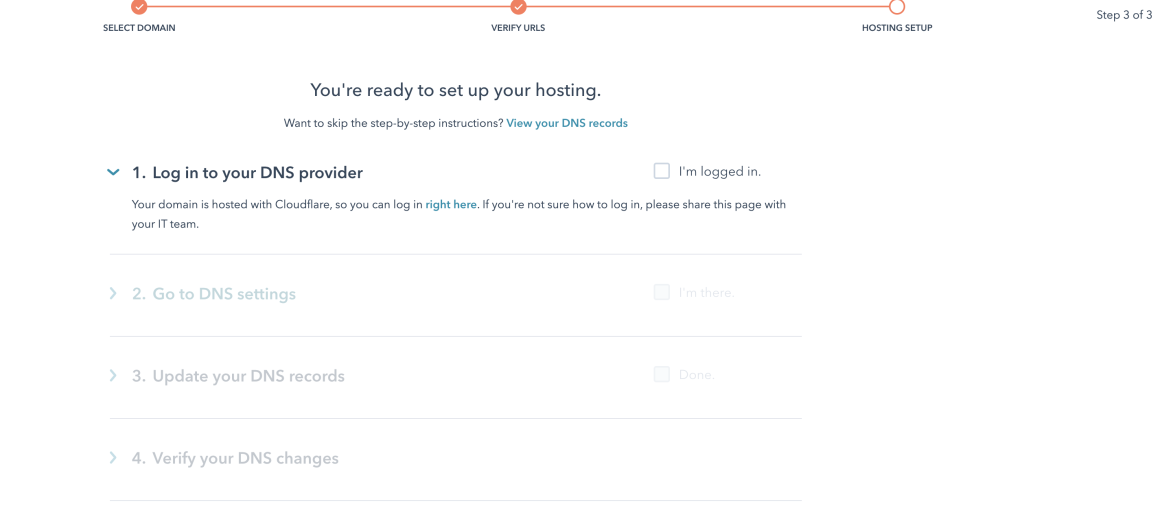
Another good example of HubSpot's onboarding experience is its unique take on a user onboarding checklist, which looks a lot like a tooltip but actually lists new tasks and keeps a progress bar down below.
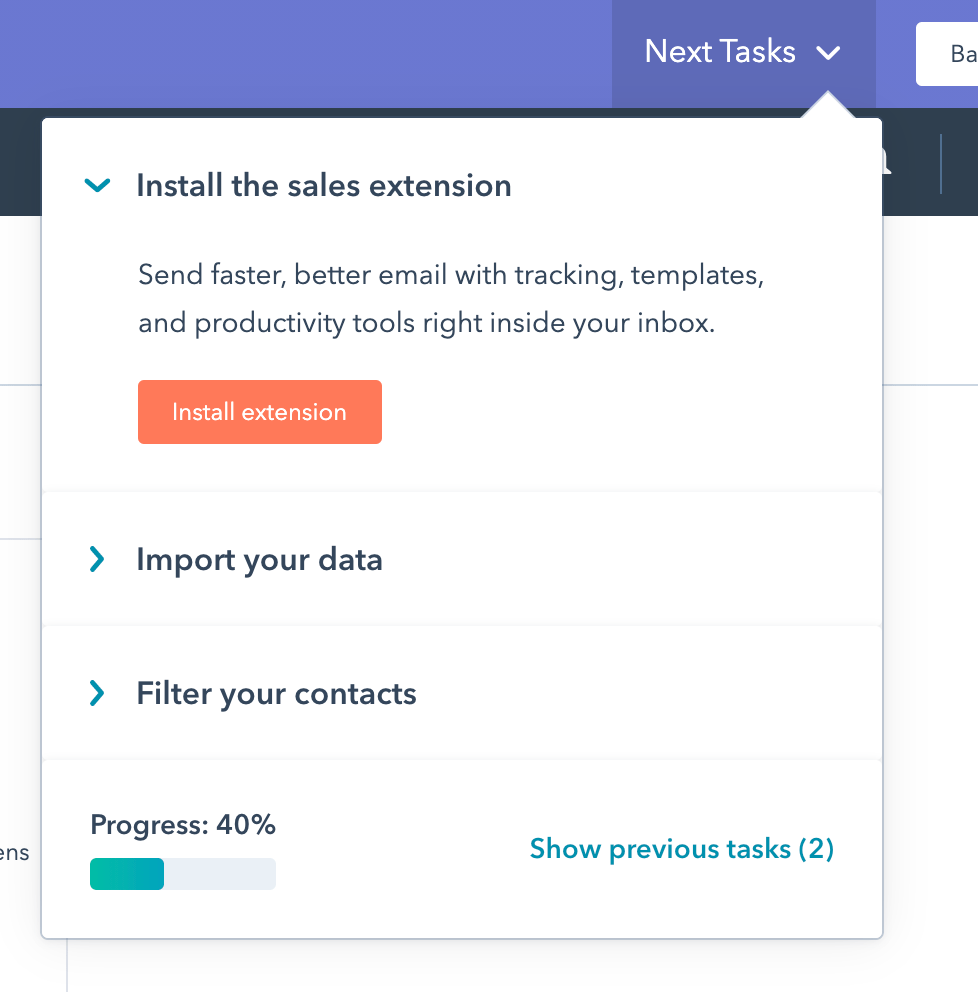
Much like any good onboarding experience, HubSpot's onboarding strategy does not come to an end after the initial onboarding.
This new feature onboarding flow of HubSpot shows use of background dimming, tooltips, progress indicators, and the best part of any product tour, a skip button.

HubSpot's very own onboarding experience is great as is, but you just might need to personalize it a bit for your own use. Here's how 👈
2- Monday.com
Though not on the same level in terms of popularity as HubSpot, Monday.com is one of the best CRM tools out there on the market as well.
And some of the praise is well deserved by the onboarding experience.
Monday.com has a very cool and very thorough sign-up process where the users are segmented according to their user personas.
Though there is a lack of a progress bar, the design of the flow is quite smooth and makes up for it.
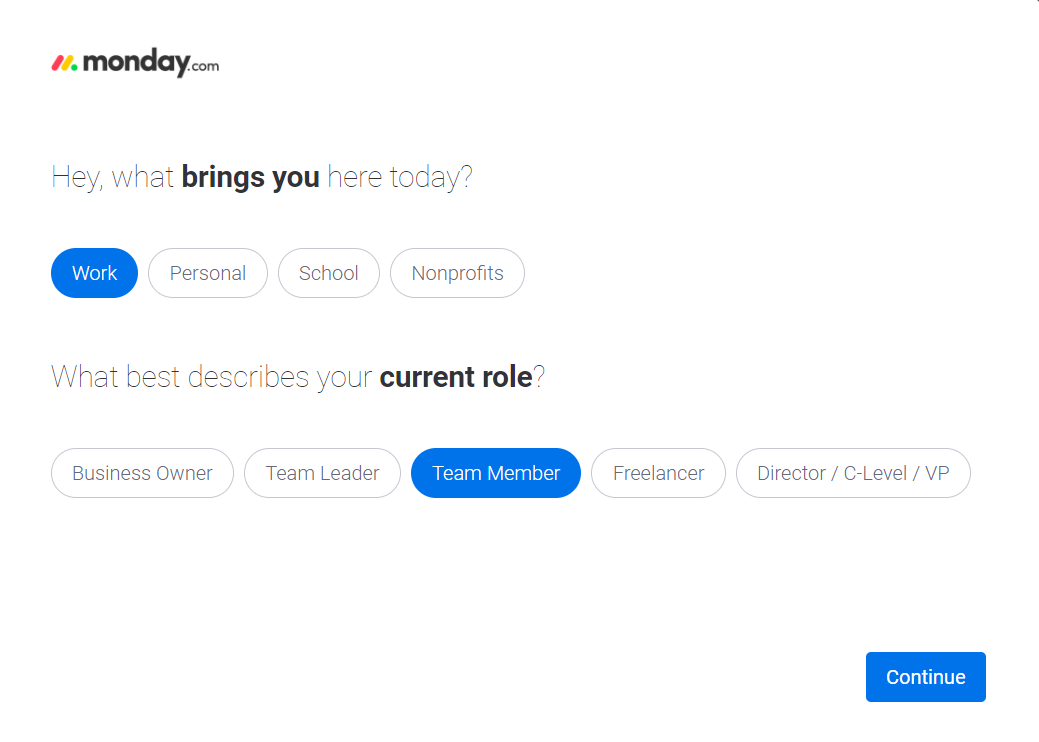
Monday.com does a great job dimming the background to highlight specific areas of the UI that needs to be introduced to the users.
Again, there is a lack of a progress indicator, but it wins heart with short copy and good formatting.
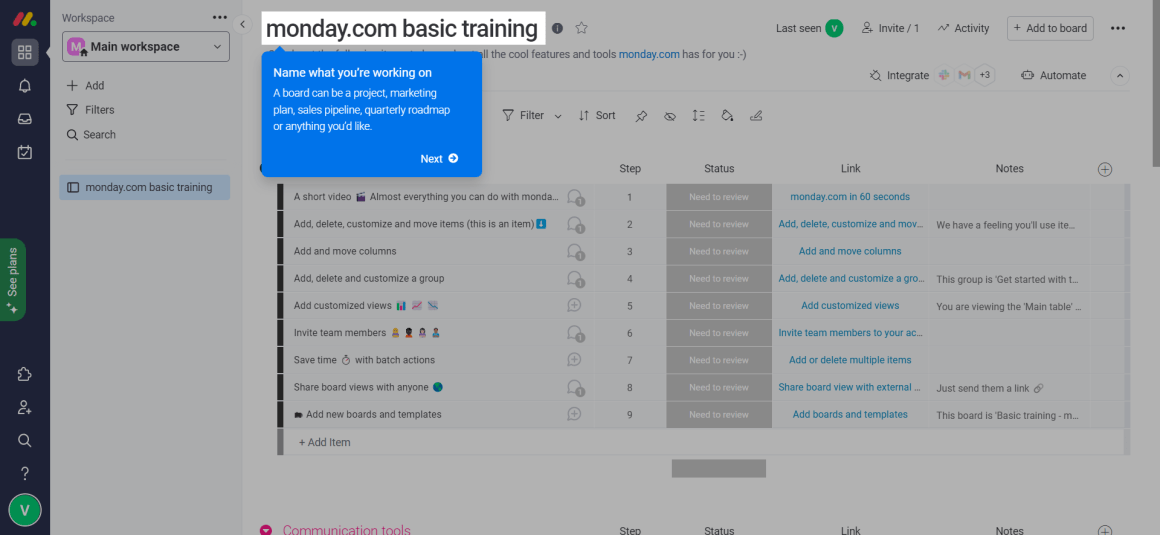
Monday.com also has a unique onboarding checklist, almost in the style of a signup flow, and videos to accompany user training.
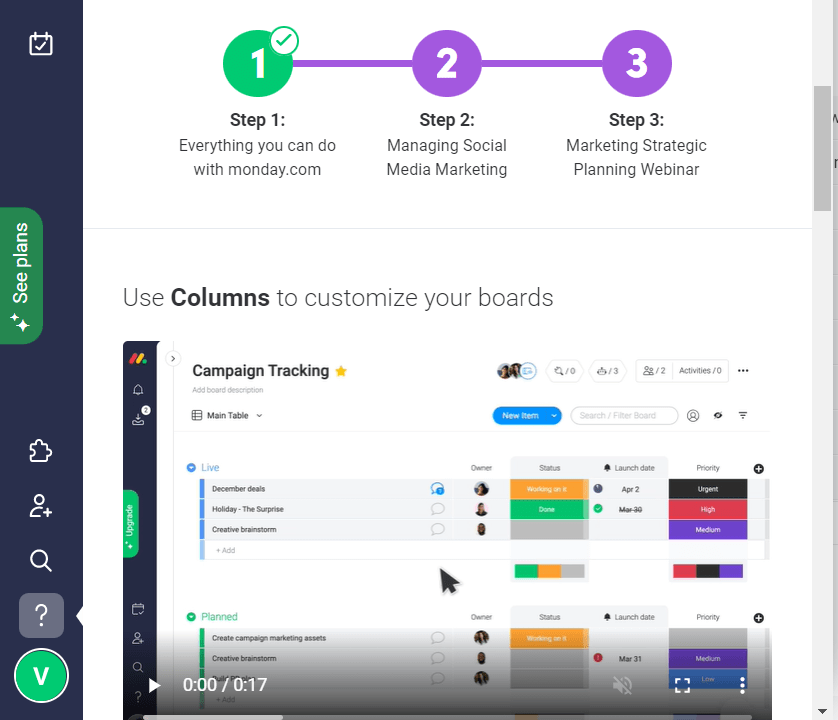
Cool right?
But, how can you do all this?
Let's take a look at how to create the perfect onboarding process for CRM tools.
3 Steps to Create the Perfect Onboarding Process for a CRM
There are quite a lot of best practices to mind when creating an onboarding process for CRM tools like
- Keeping the copy short since the tool itself is complex enough,
- Introducing each feature in-depth through contextual onboarding flows and guides,
- Using interactive guides to let the users get a feel of it, and more.
But that's all talk.
Let's use UserGuiding to create an onboarding process in a CRM tool in 3 simple steps.
Step 1: Create a Guide
We'll start by opening the UserGuiding Panel and then to the Guides section, where we'll click on "New Guide."
After naming our guide and adding the link where we'll create our guide, UserGuiding will take us to HubSpot, the CRM tool I decided to use for the perfect onboarding.

Step 2: Edit and Design
Once we are on the page we want our guide to be, we will be using the UserGuiding extension to start creating the guide.
I will first start with a fun welcome modal to send a greeting message to the users.

Then we will use some tooltips and interactive elements to liven it up.
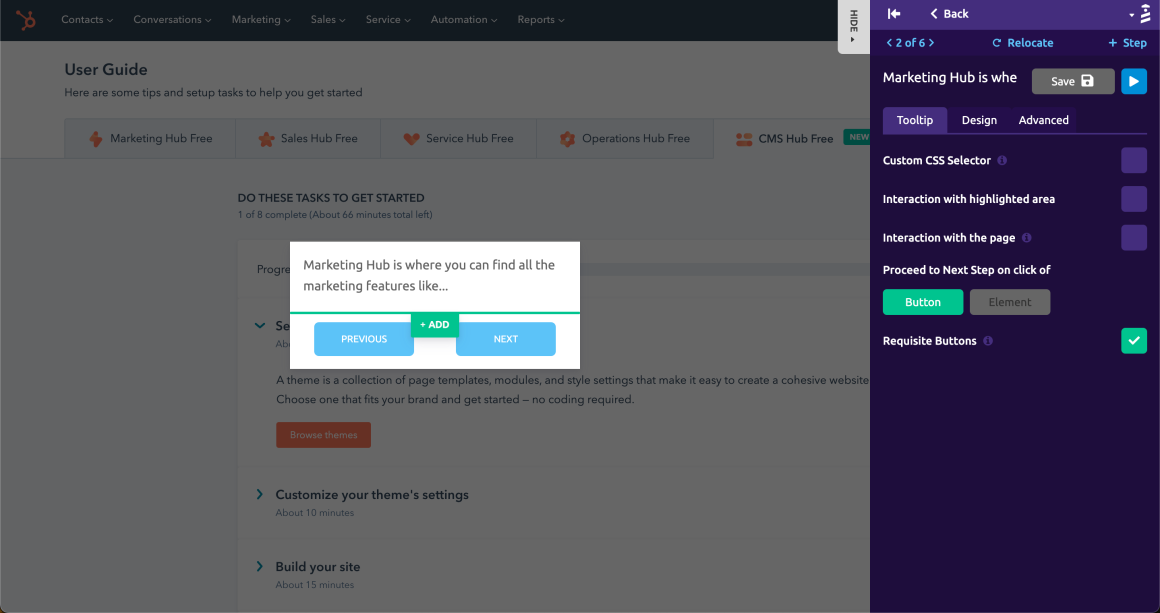
Once I'm done with this step, it'll look a little something like this:

It is up to us to keep the guide going, start a new guide for more contextual onboarding, or add different elements like hotspots or user onboarding checklists.
But for now, let's configure the guide at hand and publish.
Step 3: Configure and Publish
Once we are done with creating the guide, we can go back to UserGuiding Panel to pick the settings we want.

After turning the guide status to active, we can edit page targeting, audience segmentation, triggers, scheduling, redirection, and other advanced settings.
Once we are done, it is time to save the settings and publish changes.
Think that's the solution you need?
👉 Give UserGuiding a try for FREE 👈
To Wrap Up...
CRM tools can be a savior for your sales reps and an upper hand for marketing efforts.
As long as you know how to use it right.
And to make sure you and the rest of the team are using your CRM tool right, the best thing to do is to adopt an onboarding solution.
You can choose to go with the in-house option, and use simple options like user manuals or video guides to go over basic functionalities. But that won't be scalable of your company size is a little bigger than a startup's.
Don't risk disrupting business growth; give a no-code onboarding solution a try today.
Frequently Asked Questions
Which CRM have the best onboarding?
HubSpot and Monday.com are among the CRM tools that take onboarding seriously. Of course, there are many more CRM tools with good onboarding flows but creating one for your own team is always an option with the right onboarding solution.
What’s the best tool for CRM onboarding?
UserGuiding is among the best tools to create a CRM onboarding flow, not only for your CRM tool users but also for your employees in using CRM tools you don’t have development access to.

















.svg)
.svg)
.svg)
.svg)
.svg)

.svg)
.svg)












.svg)
.svg)




.png)
















